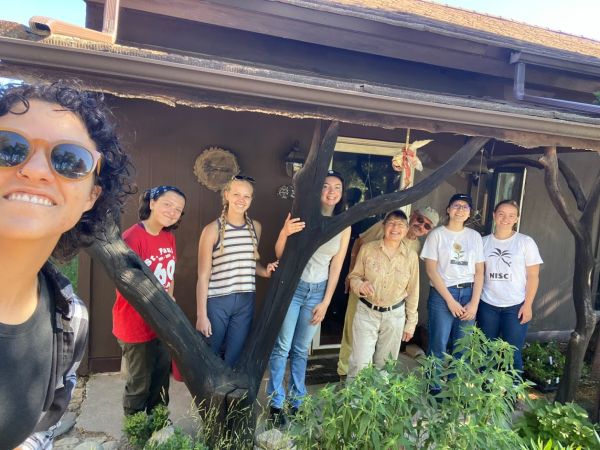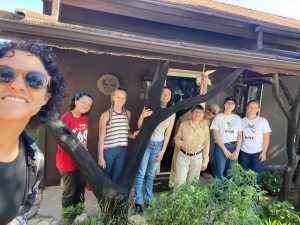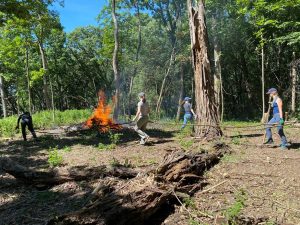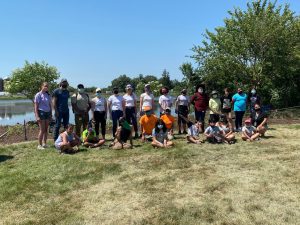
Cherries, Berries and Prairies: A Roundup of CLIP Week 3
by Kristi Robinson
Hi! I’m Kristi, one of the CLIPterns, and I’ll be leading you through a recap of this past week.

Like the past two weeks, the third week of TLC’s CLIP program was filled with countless valuable experiences and memories. We started off the week with a trip to Small Waters Education – a nonprofit organization led by Judy & Jack Speer, located in Harvard, IL, that utilizes a more holistic approach to land restoration, taking into account indigeous cultures and Native American uses for the land. We added some native plants to their food forest garden, then took a tour of the property, during which we sampled some dried berries (including, but not limited to, dried aronia berries and cornelian cherries). Lunch came with even more food samples and a short history of the property, including the land’s previous and original uses. We then learned about various medicinal and nutritional utilizations of different plants. Most notably, Black Cohosh is used to alleviate side effects of menstruation or menopause. After another short break, we ended by the day by pulling impressive amounts of Dame’s Rocket.
On Tuesday, we headed off to Tryon for a work day. Though the crew was significantly smaller than last time, we still managed to get quite a bit done; however, progress was inhibited by some major vines (oriental bittersweet and smilax, I’m looking at you) that were deeply entrenched within nearly every tree or shrub in sight. In spite of this and some pretty steamy weather, lots of honeysuckle was still cut down and burned. We also managed to find a raccoon skull (props to Arden) and seven turkey feathers (a collective effort), as well as two toads. Prior to lunch, we pulled copious amounts of ragweed and Dame’s Rocket, and simultaneously did our best to avoid stinging nettle that was abundant in the area. Afterwards, we set off to collect wild geranium seeds. We also learned about a diverse population of plants that grow at the site, including pokeweed, mayapple, and prickly ash (whose berries bear a striking resemblance to the smell of Fruit Loops).

Wednesday followed in Tuesday’s footsteps, featuring our first workday at Wolf Oak. We encountered our first major obstacle when an old hickory stump caught on fire, though its perceived inhibition to our progress was cut short by Bruce’s chainsaw skills. Though the day was largely uneventful besides the tree incident, we still managed to get quite a bit done, including wild geranium seed collection (which proved to be more successful than the previous day). We also scoured the site for any traces of second-year garlic mustard, which we did find, but thankfully not in abundance. While trying to eradicate any trace of this species, we did unfortunately find quite a bit of honeysuckle resprouts, which was sad to see but also inevitable.
Thursday took a different turn, as we headed over to McCullom Lake in McHenry to plant a pollinator garden with the Youth and Family Center of McHenry County. Each of us teamed up with another intern at various environmental organizations in the county and guided a group of kids through the process of planting a garden. It was an incredibly rewarding process, especially as a McHenry native, to be a part of permanent positive additions to the community. During our lunch, we ventured out to the lake and found a baby catfish, whom we collectively named Howie (who was the star of the show for the rest of the afternoon – and for good reason, too!). In short, the day was filled with positive experiences and lots of learning opportunities.
Friday, we went to Moraine Hills State Park (also in McHenry) and were able to spend the day with Melissa Grycan, a specialist at IDNR. We started off the day by pulling large amounts of yellow sweet clover in the hopes of clearing the way for native species. We then hiked through a bog in search of a floating mat, and while we were unsuccessful in this particular bog, we found other natural treasures, including pitcher plant and arrow leaf plant. I managed to pull a deer skull out of the mud (which is probably my favorite find of the season, so far).


Because of this year’s drought, which prevented adequate seed collection, we were able to tour another bog (this time with a floating mat), in which we found a multitude of other animal skeletons. In our quest to find an entrance to the floating mat, I did fall about knee deep in the mud, though I really can’t complain – I’d rather be knee deep in a bog than a raspberry bush (or summer calculus homework). The rest of the day went smoothly, with ATV tours of the property, stops along the prairie (which I’m certainly biased toward) and many educational plant identification moments.
All in all, CLIP’s third week was definitely successful, featuring many educational opportunities, ways to connect with communities, and of course many discoveries of our own. Stay tuned for next week’s recap, and see y’all next time!